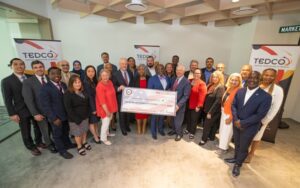
Why the BioHealth Capital Region Needs to Do More To Attract Top Talent
Hiring During a Biotech Boom: Part Two
Most companies would admit that they miss more often than they hit when it comes to talent.
McKinsey & Company recently cited three rather stunning stats about talent: (1) 82% of Fortune 500 companies don’t believe they recruit highly talented people; (2) Of companies that do believe they recruit great talent, only 7% believe they can retain it; (3) and only 23% of managers and senior executives that deal with talent-related issues believe their current strategies actually work.
The good news is that a company that improves its talent game will have a significant leg up on its competition — especially in a highly competitive market such as the BioHealth Capital Region (BHCR).
That said, for an emerging biohealth cluster like the BHCR where more new jobs are being created than there are new workers being added to the local talent pool, a good corporate talent strategy alone may not be enough to overcome the many challenges that were addressed in Part One of this series.
Ultimately, as many industry leaders are now signaling, the need for a stronger, collective “rising tide lifts all boats” talent mentality is required in order to achieve any sort of sustainable growth across the region. This “rising tide” approach is essential if the BHCR is going to be able to compete for talent against much more established and better-funded clusters such as Boston, San Francisco, and New York.
If regional companies can work together to attract talent to the pool, rather than just poaching talent from each other, then all these companies will have a chance to grow. More talent will add fuel to every element of the ecosystem and perpetuate the growth cycle over the long term.
While this seems like a “Kumbaya” approach to talent, it is, in fact, the smartest talent approach for the BHCR and was cited by numerous executives and HR leaders at conferences, panels, and events throughout last year. Perhaps the key to this “rising tide” is attracting more talent to the region to bolster the existing, highly educated and talented workforce already here.
At the ISPE MAST Showcase in 2019, Shiva Fritsch, SVP Human Resources at REGENXBIO, and Craig Malzahn, VP at GSK and Site Director of the Rockville BioPharm site, stressed increased cooperation, even among perceived competitors, and more open communication as a pathway to reaching the BHCR’s top 3 by 2023 goal. Fritsch’s statement “We can’t get there by just recruiting each other’s employees all the time. We need to do more to collectively attract more talent to the region,” received unanimous agreement among the panel.
The BHCR needs to become a more powerful magnet for top talent from outside the region to bolster the talent pool, which will create the space for growth with less cannibalization of talent among local companies.” Pulling talent from Boston, San Francisco and other more prominent, geographically consolidated, better-known clusters is a challenge and requires greater effort from across the industry to help market the region as a top destination for life science talent.
The BHCR brand name itself is a start and can be foundational to the building and marketing of a collective, regional Employee Value Proposition (EVP). What’s more — and this trend has been emerging more and more within the BHCR life science sector — individual organizations need to invest more in talent strategy, including adopting high tech approaches to recruiting and investing more in employer branding that market a given company as an attractive place to work.
Stronger employer branding and marketing efforts across the region must dovetail with better-recruiting strategies, more pervasive adoption of talent technology (including the use of AI) and the existing, ongoing efforts to promote the BHCR brand. The emerging BHCR brand needs to be bolstered by an army of strong employer brands and vice versa.
This is not enough, however.
Developing the workforce already residing within the BHCR is also critical for any chance of meeting industry demand for talent. This requires continued financial and legislative support from the various state governments, strategically coordinated efforts and a cohesive, integrated long-term vision for workforce development.
Unfortunately, this may be one of Maryland’s greatest weaknesses.
Biotech workforce development in Maryland is broken. At best, it is severely disjointed, resulting in no clear state-wide workforce development strategy. While other regions are strengthening their biotech workforce training programs and promoting them to the world, the BHCR is seeing the opposite take place.
Not only has Johns Hopkins recently pulled it’s Biotech Education program out of Montgomery County, but sources close to the University of Maryland have signaled that they have significantly reduced funding for its flagship biotech training program, BREP, that has operated out of Montgomery County and College Park. This program has been responsible for starting the careers for hundreds of bioprocessing industry leaders across the region and if eliminated will leave a substantial gap in the region’s ability to produce the workforce that so many companies desperately need.
The shining light in the workforce development arena is Montgomery College, which has a steadfast commitment to investing in their biotech programming such as their renowned Biotechnology AA program, the BioTrain continuing education programs, and the Bio-Trac advanced research training workshops. UMBC also recently launched a Translational Life Science Training program, which is beginning to take hold and aims to develop workforce-ready graduates.
However, without stronger leadership and vision, the BHCR will simply not be able to meet the industry workforce demand. The BHCR workforce strategy fails to compare with other clusters who have well-established programs such as the North Carolina Biotechnology Center; an organization that has been heralded for their workforce development programs that fuel North Carolina’s life science industry with trained talent. The type of talent that attracts companies like Audentes Therapeutics who just unveiled a $110M Gene Therapy Facility that will create 209 new jobs. Established in 1984 and funded by more than $187 million in state monies, the Center was the first state-sponsored biotechnology initiative in the U.S., merging the interests of the academic, private and public sectors.
Without some sort of bold BHCR workforce strategy, the region is sure to lose talent to Philadelphia’s burgeoning cell and gene therapy industry, where bold moves are being made.
Discovery Labs has laid out plans to build their 680,000 square foot CDMO in King of Prussia, Pennsylvania. Set to employ over 2,000 workers, it will become the world’s largest CDMO and focus on cell and gene therapy. To meet these staffing demands, Discovery Labs is planning to open up its own on-site training school, the Science University of Experiential Learning, and build on the success that the University of Pennsylvania and CHOP have already had in producing talent for cell and gene therapy production in the Philadelphia region.
Top companies are beginning to forge collaborations with local universities and trade schools to develop a more robust pipeline of trained workers. These same top companies are increasing the use of internships and apprenticeship programs.
It is clear that the BHCR needs a “rising tide” mentality that garners more involvement from industry to not only help foster these programs but to also demand stronger government, academic and nonprofit leadership to make them sustainable. The BHCR has its eyes fixed on ascending the U.S. life science cluster rankings. Stronger regional collaboration and branding that embodies a “rising tide lifts all boats” approach to attracting talent and that deploys bolder workforce development programs will put companies in a position to attract the talent they need to hire in a biotech boom.
If the BHCR can elevate and unify its workforce development strategy and investment, then it might just be in a position to compete with Boston/Cambridge, San Francisco and New York/New Jersey in ongoing and future talent wars.
- About the Author
- Latest Posts
Over the past 11 years, Chris has grown BioBuzz into a respected brand that is recognized for its community building, networking events and news stories about the local biotech industry. In addition, he runs a Recruiting and Marketing Agency that helps companies attract top talent through a blended model that combines employer branding and marketing services together with a high powered recruiting solution.






